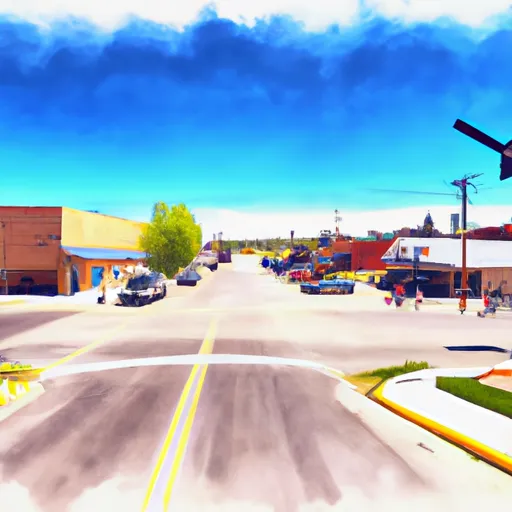-
 Snoflo Premium
Snoflo Premium
Get unlimited access to all our content
With no Ad interruptions! - Start Your Free Trial Login with existing account
Buford
Eden Index
Climate
7.0
•
Recreation
4.4
•
Community
•
Safeguard
4.3/10

Buford, Wyoming is a small unincorporated community with a population of around 1-10 people. The climate in Buford is a semi-arid climate with hot summers and cold winters. The hydrology constituents in Buford are largely influenced by the nearby Little Laramie River. Outdoor recreation opportunities in Buford include hiking, camping, fishing, and hunting in the nearby Medicine Bow National Forest. The Buford Trading Post, established in 1866, is a popular stop for travelers passing through the area. However, due to its small size and lack of services, Buford is not a popular destination for tourists or residents.
What is the Eden Index?
The Snoflo Eden Index serves as a comprehensive rating system for regions, evaluating their desirability through a holistic assessment of climate health, outdoor recreation opportunities, and natural disaster risk, acknowledging the profound impact of these factors on livability and well-being.
Climate Health Indicator (CHI): 7.0
Buford receives approximately
496mm of rain per year,
with humidity levels near 61%
and air temperatures averaging around
5°C.
Buford has a plant hardyness factor of
5, meaning
plants and agriculture in this region thrive during a short period during spring and early summer. Most
plants will die off during the colder winter months.
By considering the ideal temperature range, reliable water supplies, clean air, and stable seasonal rain or snowpacks, the Climate Health Indicator (CHI) underscores the significance of a healthy climate as the foundation for quality living.
A healthy climate is paramount for ensuring a high quality of life and livability in a region, fostering both physical well-being and environmental harmony. This can be characterized by ideal temperatures, reliable access to water supplies, clean air, and consistent seasonal rain or snowpacks.
Weather Forecast
Streamflow Conditions
South Platte
Area Rivers
South Platte
Snowpack Depths
South Platte
Reservoir Storage Capacity
South Platte
Groundwater Levels
Recreational Opportunity Index (ROI): 4.4
The Recreational Opportunity Index (ROI) recognizes the value of outdoor recreational options, such as parks, hiking trails, camping sites, and fishing spots, while acknowledging that climate plays a pivotal role in ensuring the comfort and consistency of these experiences.
Access to outdoor recreational opportunities, encompassing activities such as parks, hiking, camping, and fishing, is crucial for overall well-being, and the climate plays a pivotal role in enabling and enhancing these experiences, ensuring that individuals can engage in nature-based activities comfortably and consistently.
Camping Areas
| Campground | Campsites | Reservations | Toilets | Showers | Elevation |
|---|---|---|---|---|---|
| Flatiron Reservoir | None | 5,483 ft | |||
| Carter Lake - North Side Campgrounds | None | 5,792 ft | |||
| South Bay - Horsetooth Reservoir | None | 5,435 ft | |||
| Jacks Gulch | 56 | 8,100 ft | |||
| Kelly Flats | 29 | 6,751 ft | |||
| Carter Lake - South Side Campgrounds | None | 5,711 ft | |||
| Hermit Park Open Space | None | 8,313 ft | |||
| Inlet Bay - Horsetooth Reservoir | None | 5,437 ft | |||
| Pinewood Reservoir | 22 | 6,604 ft | |||
| Marys Lake - USBR | 270 | 8,032 ft |
Nearby Ski Areas
Catastrophe Safeguard Index (CSI):
The Catastrophe Safeguard Index (CSI) recognizes that natural disaster risk, encompassing floods, fires, hurricanes, and tornadoes, can drastically affect safety and the overall appeal of an area.
The level of natural disaster risk in a region significantly affects safety and the overall livability, with climate change amplifying these risks by potentially increasing the frequency and intensity of events like floods, fires, hurricanes, and tornadoes, thereby posing substantial challenges to community resilience and well-being.
Community Resilience Indicator (CRI):
The Community Resilience Indicator (CRI) recognizes that education, healthcare, and socioeconomics are crucial to the well-being of a region. The CRI acknowledges the profound impact of these elements on residents' overall quality of life. By evaluating educational resources, healthcare accessibility, and economic inclusivity, the index captures the essential aspects that contribute to a thriving community, fostering resident satisfaction, equity, and social cohesion.

